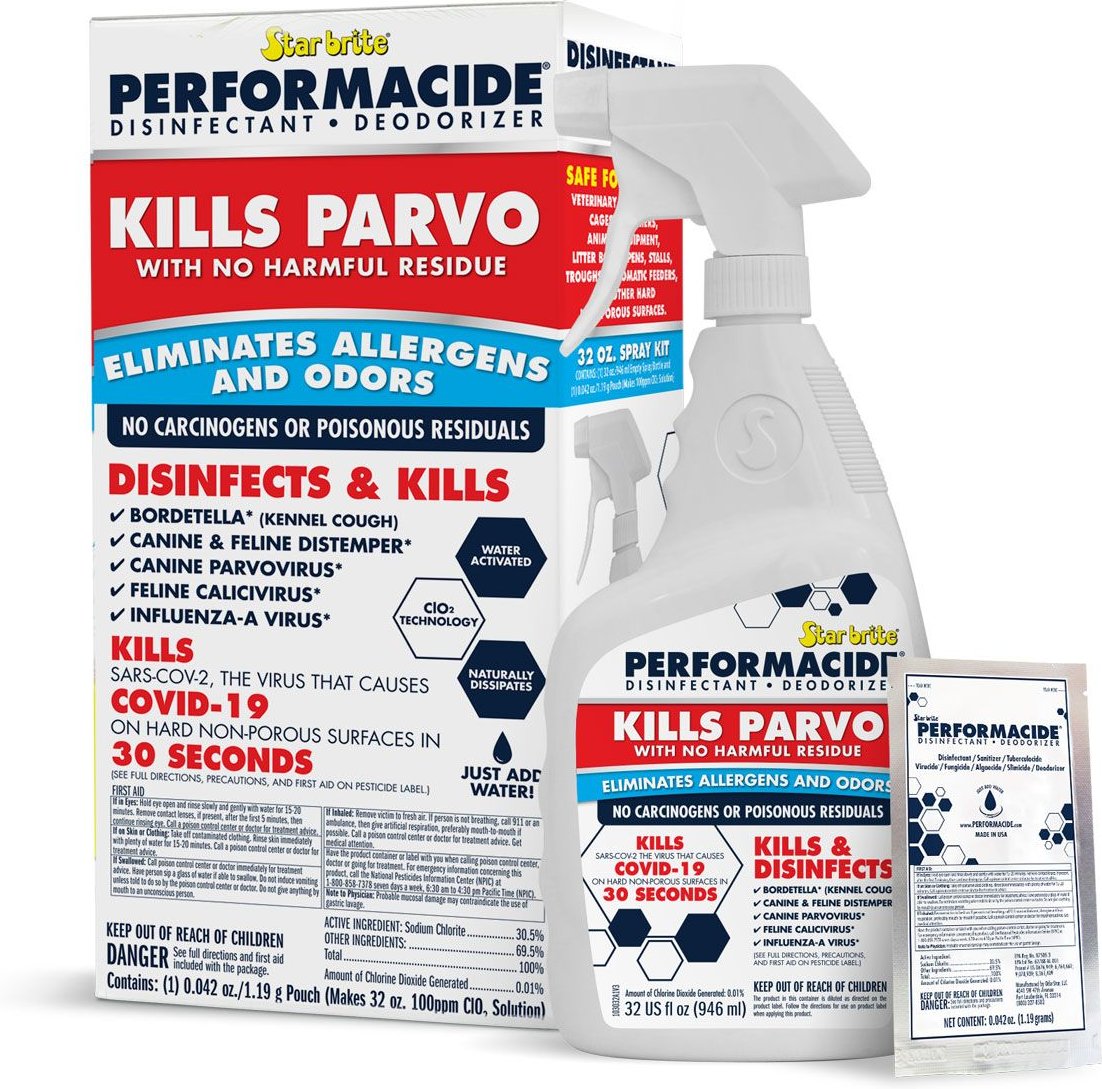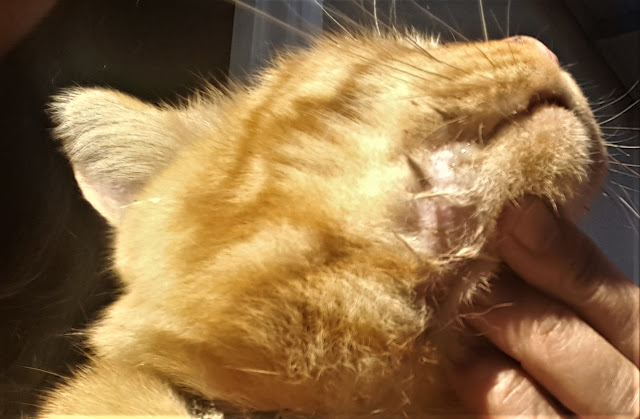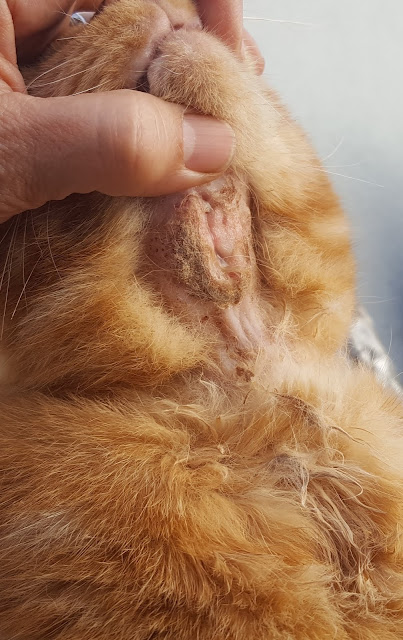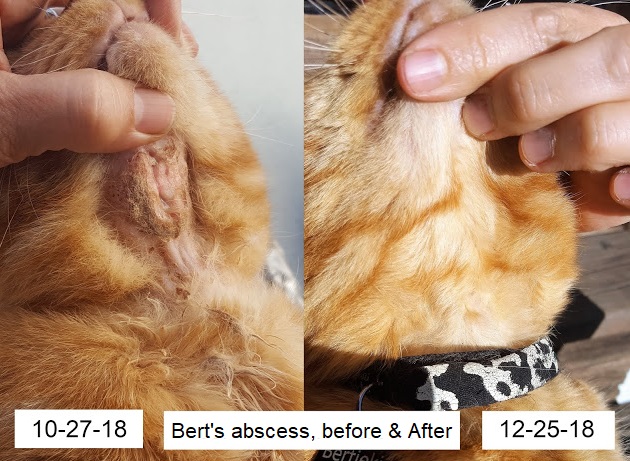 Last year, I started to suspect that HOCl was the key ingredient used in Vetericyn. I'd bought it for a cat I was fostering, about a decade ago, after meeting a woman at a dog park, who raved about how well it heals wounds. She said the bottle stated it was "made for horses," but she sheepishly confessed that she'd been spraying it on her own cuts and scrapes, and they healed right up. She made it sound like it was some kind of miracle water.
Last year, I started to suspect that HOCl was the key ingredient used in Vetericyn. I'd bought it for a cat I was fostering, about a decade ago, after meeting a woman at a dog park, who raved about how well it heals wounds. She said the bottle stated it was "made for horses," but she sheepishly confessed that she'd been spraying it on her own cuts and scrapes, and they healed right up. She made it sound like it was some kind of miracle water. It's been about 10 years since I met that woman in the park, but I always remembered what she'd said. And after hearing HOCl described as "miracle water" on many occasions, and seeing for myself how well it healed my cats' wound (pictured on the left, and you can see more pictures of, further down the page), I decided to look up Vetericyn's key ingredient. It wasn't much of a surprise that sure enough... it was hypochlorous acid!Cesar Milan has promoted Vetericyn. But I also saw that he has the same machine as I do (which makes hypohchlorous acid and antioxidant water - which many pet owners say their dogs love).
It's been about 10 years since I met that woman in the park, but I always remembered what she'd said. And after hearing HOCl described as "miracle water" on many occasions, and seeing for myself how well it healed my cats' wound (pictured on the left, and you can see more pictures of, further down the page), I decided to look up Vetericyn's key ingredient. It wasn't much of a surprise that sure enough... it was hypochlorous acid!Cesar Milan has promoted Vetericyn. But I also saw that he has the same machine as I do (which makes hypohchlorous acid and antioxidant water - which many pet owners say their dogs love).Animal Infectious Diseases
You can see that Tek-Trol disinfectant costs about $30 per gallon, at QC Supply.
The reason it costs so much is because it works. From the Tek-Trol product page:
Step-up your biosecurity measures with this highly respected germicide. Ideal for use in hatcheries, poultry and turkey barns and swine and equine facilities, Tek-Trol high-foaming disinfectant kills a broad spectrum of microorganisms. It remains active under extreme organic conditions with proven residual control. Also recommended for use in fogging systems to reduce airborne contaminants.
You can see how HOCl is used as a fogger, in a pig pen, in the video below (in my opinion, these foggers should be used in every hospital, and on every transportation system in the country).
HOCl can be used on humans, too!
You can see this study that says: "HOCl may allow for its use in a clinical situation such as in the treatment or prevention of infection in burn or other wounds." This is the study: https://www.ncbi.nlm.nih.gov/pmc/articles/PMC1853323/
Hypochlorous Acid as a Potential Wound Care Agent
CLICK HERE to see the study on Google Scholar.
Conclusions: This stabilized form of hypochlorous acid (NVC-101) could have potential application as an antimicrobial wound irrigation and treatment solution if its effective pH range can be maintained in the clinical situation. NVC-101 solution was equally effective at pH 3.5 or 4.0 and more efficient soon after its application. As opposed to other antimicrobials investigated in this animal model, NVC-101 controls the tissue bacterial bioburden without inhibiting the wound healing process.It's been written about in Wound Research.com and many other journals and studies.https://www.woundsresearch.com/article/hypochlorous-acid-ideal-wound-care-agent-powerful-microbicidal-antibiofilm-and-wound-healing You can read about it on WoundSource.com: CLICK HERE to see the study online. The Effects of Hypochlorous Acid as an Adjunct to Treatment of Chronic WoundsPuracyn Plus (pictured below) was the wound care agent used in the study. Puracyn uses Hypochlorous acid as their active ingredient for disinfection. Puracyn Plus costs about $1.41 per ounce, but it is a very effective woundcare agent, so in my opinion, it's worth it! You can see an excerpt from the study below.Puracyn Plus Wound and Skin Cleanser – Wound Care Spray for cuts, scrapes, minor sores, minor burns, and other skin irritations – 16-ounce
Patient Outcomes
Patients 1-7 experienced substantial decreases in wound size. Patient #1 had an 85% decrease in their wound, while Patient #2 had a 30% decrease in their wound. By the end of the study there were no patients who presented with wounds with bioburden, eschar, or odor.
Patients 1-7 experienced substantial decreases in wound size. Patient #1 had an 85% decrease in their wound, while Patient #2 had a 30% decrease in their wound. By the end of the study there were no patients who presented with wounds with bioburden, eschar, or odor.
Conclusion
Cleansing with Puracyn Plus and implementing a 5 minute soak prior to the treatments had a substantial beneficial impact on wound healing. Using Puracyn Plus to cleanse the wounds, as opposed to saline and commercial wound cleansers with surfactants demonstrated a 95% reduction in wound size and a reduction in chronic wound-related complications, resulting in healthier chronic wounds with faster healing times.
Cleansing with Puracyn Plus and implementing a 5 minute soak prior to the treatments had a substantial beneficial impact on wound healing. Using Puracyn Plus to cleanse the wounds, as opposed to saline and commercial wound cleansers with surfactants demonstrated a 95% reduction in wound size and a reduction in chronic wound-related complications, resulting in healthier chronic wounds with faster healing times.

.
Performacide Kills Parvo Disinfectant - Kills Parvovirus, Human Coronavirus 229E (HCoV-229E), Influenza-A, Feline Calicivirus, Avian Influenza-A - 32 oz. Single Kit
Brutabs uses HOCl, and it is also used to kill a variety of animal pathogens.
As it states in their brochure:
Kills C. difficile spores, TB and more in 4 minutes. Kills Norovirus, Hepatitis A Virus, Hepatitis B Virus, Hepatitis C Virus and HIV-1 in 1 minute. Hospital Disinfectant; Meets OSHA Bloodborne Pathogens* Standard; Sanitizer Claim for Food Service Applications; Kills Canine Parvovirus. * Kills HBV and HIV-1 on pre-cleaned environmental surfaces/objects previously soiled with blood/body fluids.
FAC exists in two forms, Hypochlorous acid (HOCl) found in BruTab 6S solutions and Hypochlorite ion (OCl-) found in a bleach solution. Studies have shown that Hypochlorous acid has 4X (four times) more disinfection power than the hypochlorite ion. HOCl is very similar to the water molecule allowing it to easily penetrate through the negatively charged cell wall. Once the HOCl enters the microorganism, it destroys the nucleus of the cell completing the disinfection process. The Hypochlorous acid found in bleach is used up very quickly, it doesn’t penetrate the cell as easily and solutions must be replaced more often, especially in the presence of organic loads
My own experience using HOCl on pets
 (Note: I have many more stories than this, but I'm posting this story because it's I have the most photographs of my cat's progress in healing). This is just one of many instances where I've used HOCl on my cats, with outstanding results.
(Note: I have many more stories than this, but I'm posting this story because it's I have the most photographs of my cat's progress in healing). This is just one of many instances where I've used HOCl on my cats, with outstanding results. In the fall of 2018, when I was taking care of a very close family friend in critical condition, my cat Bert developed a bad abscess. I wasn't able to spend as much time with him as I normally do, and I wasn't aware that he had developed this wound on his neck (the heat didn't help matters). I began spraying it with hypochlorous acid regularly, and his healing was pretty amazing. I'm posting some photos below. Warning, some of them are pretty bad looking, but I feel grateful that it healed so quickly. I'm posting the full-resolution photos so that people can see the details of how bad this wound was. I'm planning to show these pics to a few veterinarians as well.
10-21-18
The day I discovered Bert's abscess. Poor baby, his whole lower jaw area seemed to be swollen : (.
He was being a real trooper, not squirming too much while I took all these pics. 💓 I took a lot.
10-27-18
This is six days after I started spraying the abscess. I would have taken more photos but things were pretty chaotic while I was helping my friend who was extremely sick in the hospital. I realize there is a lot of gunky fur stuck to the bare skin around Bert's wound, but I chose not to mess with it, and think it was for the best, because it just went away on its own, as new fur grew back in.
Sorry, I know this one looks really, really bad.
Poor Bert!

10-28-18
I could no longer see pus at the top of the wound, and it seemed to heal quickly after this (I did continue spraying it a few more times). I was so busy around this time, this was the last day I took photos (that I can find) until his fur had already grown back in. But if I find more, I will be sure to post them here.
I know this photo below is pretty graphic, but I'm posting some of these pics in high resolution so you can see how well my cat's abscess healed.
Full size:

It's probably a good thing that my naked eye couldn't see there was a black hair entangled in this wound, or I would have felt compelled to tweeze it out.
10-17-19 Update: Earlier this week, I found some photos (the next 3, taken on 10-31 and 11-5) that I had apparently forgotten I had taken... they had gotten buried on a hard drive. So I'm adding them, below.
10-31-18
11-5-18
I wish I'd taken a few more photos than this, showing how the fur was slowly growing back in, but things were pretty chaotic at that time, so this is all I have.
Again, here is the before and after pic of Bert's wound, showing how well it had healed, by Christmas day (just over 2 months after I started treating it ). And again, I do believe that it was probably healed sooner than this (maybe closer to the 6-week mark), but this is the first photo I took after I saw the wound had healed completely.
These are some more recent pics (taken 2-11-19) of the same area where the wound was. He does usually wear a collar with a fairly large nametag, so I believe that is why his fur looks flat in the collar area.
Here's a photo of Bert, taken on 2/16. He actually slipped and fell recently, on a very rainy day, and had an injured back leg that is still healing. But I've been giving him antioxidant drinking water from our machine, plus PEMF (you can read about PEMF technology, here) and a good amount of chia seeds in his wet food with probiotics (I have a whole recipe on this page)....plus, I try to give him extra attention... and he's doing great! He turns 16 in May : ).
If you live in my area and have a pet that develops a bad wound, I am supposed to tell you that you should take your pet to a veterinarian. However, if you would like to try some hypochlorous acid (or alkaline antioxidant water), I can give you a 2-week supply.
Just bring a glass bottle to store it in your fridge, and also a cooler (a soft cooler with an ice pack is fine) that is big enough to hold the bottle and keep it cool while you take it home. You need to store it in the fridge when you get home. For the drinking water, you can just bring any gallon-sized bottle, though glass is always the best (it's just heavy).
For the HOCl, you can bring any small, air tight glass jar (like a small pickle jar) and transport it when needed, to a small dark glass spray bottle (which you can get from Whole Foods for less than $5). It's best to keep the rest of the HOCl in the other glass container that is air tight (HOCl reacts with oxygen, and will lose it's efficacy sooner, in a spray bottle).
Let me know if you have any questions!

























